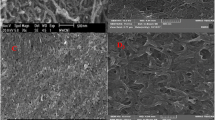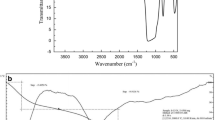Abstract
The development of Point Of Care (POC) systems for applications in biorecognition has motivated research on sensor platforms in which their electrochemical responses can be obtained without the use of redox probes. This paper describes the design and characterization of a film is composed by conductive polymers, nanoparticles and special organic salts. The platform consists of a film of Polianiline, Fulerene C60 and TCNQ, produced on the surface of a glassy carbon electrode and deposited using the drop-casting technique. For the characterization, the electrochemical cyclic voltammetry technique was used. In addition to the voltammogram profile, the reversibility of the platform was analyzed the anodic and cathodic peak current as a function of the scanning speed and its stability. The results demonstrate that produced platform presents significant increase in electron transfer and good electrochemical stability. The main characteristic of the produced platform is that they were tests electrochemical performed without the presence of a redox probe, indicating that all the electron transfer is conducted by the conductive characteristics of the film which was produced and occurrence and because the species generated on the surface the electrode. This represents the initial stage in the development of POC biosensors.
Access this chapter
Tax calculation will be finalised at checkout
Purchases are for personal use only
Similar content being viewed by others
References
Figueiredo A, Vieira NC, dos Santos JF et al (2015) Electrical detection of dengue biomarker using egg yolk immunoglobulin as the biological recognition element. Sci Rep 5:7865.https://doi.org/10.1038/srep07865
Laura GC, Aida M, Sempionatto J et al (2019) Pacifier biosensor: toward noninvasive saliva biomarker monitoring. Anal Chem 29(21):13883–13891. https://doi.org/10.1021/acs.analchem.9b03379
Liu Y, Yu H, Alkhamis O et al (2020) Tuning biosensor cross-reactivity using aptamer mixtures. Anal Chem 92(7):5041–5048. https://doi.org/10.1021/acs.analchem.9b05339
Kou X, Tong L, Shen Y et al (2020) Smartphone-assisted robust enzymes@MOFs-based paper biosensor for point-of-care detection. Biosens Bioelectron 156:1–9. https://doi.org/10.1016/j.bios.2020.112095
Chen L, Wang E, Tai C et al (2020) Improving the reproducibility, accuracy, and stability of an electrochemical biosensor platform for point-of-care use. Biosens Bioelectron 155:1–8. https://doi.org/10.1016/j.bios.2020.112111
Wang S, Zhao Y, Wang M et al (2019) Enhancing luminol electrochemiluminescence by combined use of cobalt-based metal organic frameworks and silver nanoparticles and its application in ultrasensitive detection of cardiac Troponin I. Anal Chem 91(4):3048–3054. https://doi.org/10.1021/acs.analchem.8b05443
Wang S, Li C, Saqib M et al (2020) Quasi-photonic crystal light-scattering signal amplification of SiO2-nanomembrane for ultrasensitive electrochemiluminescence detection of cardiac Troponin I. Anal Chem 92(1):845–853. https://doi.org/10.1021/acs.analchem.9b03472
Li Y et al (2012) Chemical engineering research and design comparative study of methylene blue dye adsorption onto activated carbon, graphene oxide, and carbon nanotubes. Chem Eng Res Des 91(2):361–368. https://doi.org/10.1039/c3dt32969k
Yang X, Yang M, Zhang H et al (2018) Electro-purification of carbon nanotube networks without damaging the assembly structure and crystallinity. Appl Surf Sci 442:232–238. https://doi.org/10.1016/j.apsusc.2018.02.169
Raslan A, Saenz Del B, Laura C et al (2020) Graphene oxide and reduced graphene oxide-based scaffolds in regenerative medicine. Int J Pharma. 580: 1–14. https://doi.org/10.1016/j.ijpharm.2020.119226
Shpilevsky EMF (2019) Properties of metal-fullerene composites. Solid State Phenom 288:124–129
Goodarzi SR et al (2019) Fullerene: biomedical engineers get to revisit an old friend. Mater Today. https://doi.org/10.1016/j.mattod.2017.03.017
Nascimento GM (2004) Synthesis and characterization of nanocomposites of conductive polymers with clays, thesis (Doctorate)—Institute of Chemistry. University of São Paulo, São Paulo
Costa JCM (2012) Synthesis and galvanic characterization of polyaniline for application in supercapacitors. (Dissertation)
Naik IB et al (2019) Optical and electrical properties of TCNQ doped PMMA films. In: AIP conference proceedings
Ungor O et al (2019) Magnetism and electrical conductivity of molecular semiconductor [FeII(DMF)4(TCNQ)2](TCNQ)2, with Fractionally Charged TCNQ Units. J Magn Magn Mater. https://doi.org/10.1016/j.jmmm.2019.165984
Bard AJ et al (2001) Electrochemical methods FUNDAMENTALS and applications. [s.l: s.n.]
Kubo T et al (2012) Facile synthesis of Trinaphtho [3.3.3] propellane and its π-extension aimed for two-dimensional honeycomb molecular assembly 1–3. https://doi.org/10.1039/C4CC09883H
Acknowledgements
This work was funded by the Coordination for the Improvement of Higher Education Personnel (CAPES).
Conflict of Interest
The authors declare that there is no conflict of interest.
Author information
Authors and Affiliations
Corresponding author
Editor information
Editors and Affiliations
Rights and permissions
Copyright information
© 2022 Springer Nature Switzerland AG
About this paper
Cite this paper
Gomes, R.M., Lima, R.A., Dutra, R.A.F. (2022). Electrochemical Characterization of Redox Electrocatalytic Film for Application in Biosensors. In: Bastos-Filho, T.F., de Oliveira Caldeira, E.M., Frizera-Neto, A. (eds) XXVII Brazilian Congress on Biomedical Engineering. CBEB 2020. IFMBE Proceedings, vol 83. Springer, Cham. https://doi.org/10.1007/978-3-030-70601-2_342
Download citation
DOI: https://doi.org/10.1007/978-3-030-70601-2_342
Published:
Publisher Name: Springer, Cham
Print ISBN: 978-3-030-70600-5
Online ISBN: 978-3-030-70601-2
eBook Packages: EngineeringEngineering (R0)




